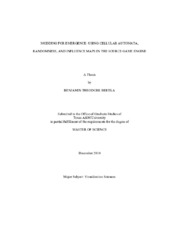| dc.contributor.advisor | Srinivasan, Vinod | |
| dc.creator | Bertka, Benjamin Theodore | |
| dc.date.accessioned | 2012-02-14T22:18:22Z | |
| dc.date.accessioned | 2012-02-16T16:20:24Z | |
| dc.date.available | 2012-02-14T22:18:22Z | |
| dc.date.available | 2012-02-16T16:20:24Z | |
| dc.date.created | 2010-12 | |
| dc.date.issued | 2012-02-14 | |
| dc.date.submitted | December 2010 | |
| dc.identifier.uri | https://hdl.handle.net/1969.1/ETD-TAMU-2010-12-8736 | |
| dc.description.abstract | Recent advances in the field of educational technology have promoted the
re-purposing of entertainment-oriented games and software for educational applications.
This thesis extends a project developed at Texas A&M University called Room 309, a
re-purposed modification of Valve Software’s Source Development Kit that models
classroom scenarios to pre-service teachers. To further explore effectiveness in the area
of re-playability, this work incorporates emergent game behaviors and environments
using cellular automata, randomness, and influence maps within the existing nonemergent
structure. By introducing these qualities game play is expected to become less
predictable, thus increasing the effectiveness of Room 309 as a learning tool. | en |
| dc.format.mimetype | application/pdf | |
| dc.language.iso | en_US | |
| dc.subject | Gaming | en |
| dc.subject | Game Engine | en |
| dc.subject | Mod | en |
| dc.subject | Modding | en |
| dc.subject | Cellular Automata | en |
| dc.subject | Influence Maps | en |
| dc.subject | Artificial Intelligence | en |
| dc.title | Modding for Emergence: Using Cellular Automata, Randomness, and Influence Maps in the Source Game Engine | en |
| dc.type | Thesis | en |
| thesis.degree.department | Visualization | en |
| thesis.degree.discipline | Visualization Sciences | en |
| thesis.degree.grantor | Texas A&M University | en |
| thesis.degree.name | Master of Science | en |
| thesis.degree.level | Masters | en |
| dc.contributor.committeeMember | Galanter, Phillip | |
| dc.contributor.committeeMember | Smith, Dennie | |
| dc.type.genre | thesis | en |
| dc.type.material | text | en |


